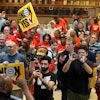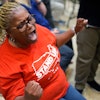The world isn’t ending, but it sure is tense out there.
On Friday, Standard & Poor made the bold move to downgrade the United States’ credit rating for the first time in history. As a result, yesterday’s session on Wall Street saw the biggest drop since the 2008 meltdown.
Adding to the unstable atmosphere is today’s recall election for six Wisconsin senators -- a vote that could shift power in the Senate to the Democrats and strike a blow to Governor Scott Walker’s agenda to cut costs and reduce the deficit (not likely, though).The two parties and special interest groups have spent $31 million on the recall elections, highlighting the national interest in this race.
Lost amongst our fiscal and political concerns are the riots and looting that have been rolling through the London area for close to four days. The riots broke out on Saturday during a “peaceful march” to denounce the police shooting of 29-year-old Mark Duggan.
Thankfully, no one has been killed (yet). UPDATE: The first riot-related death has been reported.
As you read this, a disturbing but fascinating scenario is playing out in the UK capital -- one that offers valuable lessons on the powerful new dynamic of social media in disaster response and crisis management:
- The public Facebook tribute page “R.I.P. Mark Duggan” appeared soon after Thursday’s shooting, set up by a group of “known activists” hoping to use the event as a platform to oppose police brutality. The page quickly became a “royal rumble.” Even with Facebook’s lack of anonymity, racist comments and personal attacks are widespread on the page.
- The name and shame process is up and running. The Facebook page mentioned above contains a video of youths stealing items from an injured man’s backpack.A similar name and shame phenomenon was seen after the Vancouver riots.
- An anti-riot movement has emerged and is using Twitter to denounce looters and mobilize cleanup crews. These are not public officials -- just people that are ashamed and upset by the violence overtaking their city. Search Twitter for the hashtag #riotcleanup to see the extent of these efforts.
- A new twist has emerged in the way that protesters organize themselves. While Twitter and, to a lesser extent, Facebook offer a public platform for meeting places and times to be broadcast, looters in London have taken to the BlackBerry Messenger (BBM) service due to the fact that it is free, and the conversations are private and not immediately visible to authorities.
- Bringing information and data security into the equation, BlackBerry maker Research In Motion tweeted that they have “engaged with the authorities to assist in any way we can.” The “private messaging” service will no doubt be opened up for the authorities to monitor. Ironically, a message was circulated on BBM warning rioters to stop using the service.
- In what seems to be a slightly out-of-touch comment, the deputy assistant commissioner of London’s Metropolitan police blamed “social media and other methods” for the disorder gripping the city. It’s kind of like blaming AT&T for allowing people to send drunken text messages. To me, this mindset makes it obvious that the police are not effectively using social media to monitor protesters’ movements and communicate with protest organizers and the public.
- Police also warned that people using Twitter to incite violence will be prosecuted.
- On a lighter note, the London-based celebrities and musicians I follow on Twitter are tweeting about what they can see and hear. Getting live updates from Mark Ronson, Wayne Rooney and Ed Simons (Chemical Brothers) is surreal.
The racial undertones of the London riots remind me of the 1992 L.A. riots; however, instead of relying exclusively on news coverage for situational awareness (as seen when bystanders came to help truck driver Reginald Denny after seeing him beaten on live TV), London rioters have multiple channels to disseminate information.
Crisis managers and officials are left with no choice. They have to develop systems to access, analyze and respond to the information that is being put out there.
Do you have social media protocols in your crisis management plans? Send me an email at [email protected] or leave a comment in the field below.






















